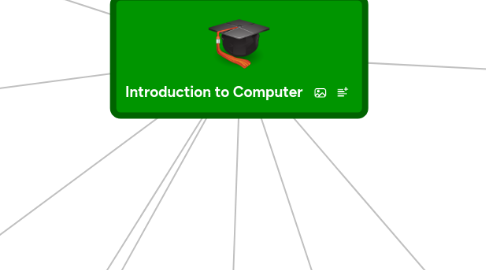
1. Objective Overview
1.1. Explain why computer literacy is vital to success in today’s world.
1.2. Define the term computer, and describe the between data and information.!
1.3. Describe the five components of a computer.
1.4. Discuss the advantages that users experience when working with computer.
1.4.1. New node
1.5. Define the term network, and identify benefits of sharing resources on a network.
1.6. Discuss the uses of the internet and world wide web.
1.7. Distinguish between system software and application software.
1.8. Differentiate among types, sizes, and function of computer in the each category.
2. Computer Software
2.1. Software, also called a program, tells the computer what tasks to perform and how to perform them.
2.1.1. System Software
2.1.1.1. Operating system
2.1.1.2. Utility programApplication
2.1.2. Application Software
2.2. Installingis the process of setting up software to work with the computer, printer, and other hardware.
2.3. A programmer develops software or writes the instructions that direct the computer to process data into information.
3. Categories of Computers
3.1. Personal Computers
3.1.1. A personal computercan perform all of its input, processing, output, and storage activities by itself.
3.1.2. Two popular architectures are the PC and the Apple.
3.1.2.1. Desktop computer
3.2. Mobile Computers and Mobile Devices
3.2.1. Notebook computer
3.2.2. Tablet PC
3.2.3. Smart phone
3.2.4. PDA
3.2.5. Handheld computer
3.2.6. Portable media player
3.2.7. Digital camera
3.3. Game Consoles
3.3.1. A game consoleis a mobile computing device designed for single‐player or multiplayer video games.
3.4. Servers
3.4.1. A servercontrols access to the hardware, software, and other resources on a network.
3.4.1.1. Provides a centralized storage area for programs, data, and information.
3.5. Mainframes
3.5.1. A mainframeis a large, expensive, powerful computer that can handle hundreds or thousands of connected users simultaneously.
3.6. Supercomputers
3.6.1. A supercomputeris the fastest, most powerful computer.
3.6.1.1. Fastest supercomputers are capable of processing more than one quadrillion instructions in a single second.
3.7. Embedded Computers
3.7.1. An embedded computeris a special‐purpose computer that functions as a component in a larger product.
4. Elements of an Information System
4.1. Hardware
4.2. Software
4.3. Data
4.4. People
4.5. Procedures
5. Examples of Computer Usage
5.1. Home User
5.1.1. Personal financial management
5.2. Small Office/Home Office User
5.2.1. Look up information
5.3. Mobile User
5.3.1. Connect to other computers on a network or the Internet
5.4. Power User
5.4.1. Work with multimedia
5.5. Enterprise User
5.5.1. Communicate among employees
6. Computer Applications in Society
6.1. Education
6.2. Finance
6.3. Government
6.4. Health Care
6.5. Science
6.6. Publishing
6.7. Travel
6.8. Manufacturing
7. Summary
7.1. Basic computer concepts.
7.2. Components of a computer.
7.3. computerNetworks, the Internet, and computer software.
7.4. Many different categories of computers, computer users, and computer applications in society.
8. A World of Computers
8.1. Computers are everywhere.
9. The Components of a Computer
9.1. A computer contains many electric, electronic, and mechanical components known as hardware.
9.1.1. Input Device
9.1.1.1. Allows you to enter data and instructions into a computer.
9.1.2. Output Device
9.1.2.1. Hardware component that conveys information to one or more people.
9.1.3. System Unit
9.1.3.1. Case that contain the electronic component of the computer that are used to process data.
9.1.4. Storage Device
9.1.4.1. Holds data, Instructions, and formation for future use.
9.1.5. Communications Device
9.1.5.1. Enables a computer to send and receive data instruction to and from one or more computer or mobile devices.
10. What Is a Computer?
10.1. A computeris an electronic device, operating under the control of instructions stored in its own memory.
11. Advantages and disadvantages of Using Computers
11.1. Advantages of Using Computers
11.1.1. Speed
11.1.2. Reliability
11.1.3. Consistency
11.1.4. Storage
11.1.5. Communications
11.2. Disadvantages of Using Computers
11.2.1. Health Risks
11.2.2. Violation of Privacy
11.2.3. Public Safety
11.2.4. Impact on Labor force
11.2.5. Impact on Environment
11.3. Green computing involves reducing the electricity consumed and environmental waste generated when using a computer.
11.4. Strategies Include
11.4.1. Recycling
11.4.2. Regulating manufacturing processes
11.4.3. Extending the life of computers
11.4.4. Immediately donating or properly disposing of replaced computers
12. Networks and the Internet
12.1. A networkis a collection of computers and devices connected together, often wirelessly, via communications devices and transmission media.
12.2. The Internet is a worldwide collection of networks that connects millions of businesses, government agencies, educational institutions, and individuals.
12.3. People use the Internet for a variety of reasons:
12.3.1. Communicate
12.3.2. Research and Access Information
12.3.3. Shop
12.3.4. Bank and Invest
12.3.5. Online Trading
12.3.6. Entertainment
12.3.7. Download
12.3.8. MusicShare
12.3.9. VideosWeb
12.3.10. Application
